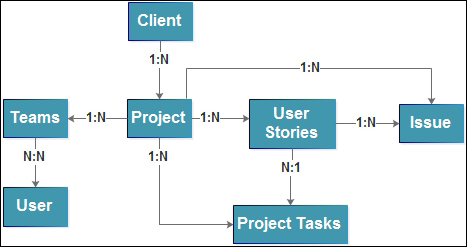In this chapter, we will be creating a sample project tracking application utilizing different Microsoft Dynamics CRM features. We will be setting up custom entities for our application and will learn how to use rollup fields to show aggregations from child entities. We will also see how we can use calculated field for performing calculations using formulas. We will learn about the activity feed feature in CRM 2015 and will learn about configuring activity feeds for entities and activity feed rules as follows.
- Creating a project tracking application
- Project tracking application design
- Customizing CRM 2015 for the project tracking application
- Using rollup fields for aggregation
- Understanding activity feeds
- Configuring activity feeds
- Setting up teams
- Creating charts and dashboards
In this chapter we are going to develop a custom solution for a project tracking application. In this solution, we are going to develop features required by project management software. Project tracking applications are used by companies to create the main project life cycle. A traditional project tracking application provides the following features:
- Ability to maintain project catalogs
- Maintain a list of the project user stories and project tasks
- Ensure visibility of the project task status
- Manage project timesheet entries
- Clear view of project issues submitted and resolved
- Maintain project teams
- Ability to maintain project-related documents
- Ability to schedule project meetings
- Data visualization for the projects status
All the preceding features can be implemented using CRM 2015's out-of-the-box capabilities; we will be customizing CRM 2015 to achieve all the preceding requirements for our custom solution. We will be using the CRM 2015 online trial for this application. You can set up the CRM 2015 online trial using the http://www.microsoft.com/en-sg/dynamics/Default.aspx link.
To map our application requirements, we will be using some out-of-the-box entities and creating some custom entities to capture project-related information. The following table provides information about the entities that we will be using:
|
Name |
Type |
Description |
|---|---|---|
|
Account |
System |
Account entity is used to store client information |
|
Project |
Custom |
A custom entity to store project details |
|
User stories |
Custom |
Custom entities used to store user store/use cases of the project |
|
Project tasks |
Custom |
This entity is used to store the project task details |
|
Issue |
Custom |
This entity is used to store project issue details |
|
User |
System |
To store project team members |
|
Team |
System |
To store project team details |
|
Activity entities |
System |
We will be using activity entities such as tasks, e-mails, and appointment for maintaining different activities |
We need to set up a parent child relationship for the preceding entities; for example one account can have any number of projects, and similarly one project can have any number of project tasks and user stories. So we need to set up a 1: N relationship between these entities.
The following diagram represents the relationship between these entities:

